S.McWhirter–W.Engel
Route 20 Chess Club
Freeport, Ill., Nov. 23, 2010
1.d4 f5
I hate playing against the Dutch. Glad it's Steve and not me.
2.c4 Nf6 3.Bg5?!
More typical white third moves are Nc3, Nf3 and g3. This move promptly launches the game out of book, although not into completely unexplored territory: according to ChessBase, Vladimir Raičević used it to beat GM Slobodan Martinović in Valjevo, Yugoslavia, in 1984. So there.
3...d6 4.Bxf6 gxf6
May 4...exf6 be slightly better?
5.Nc3 e5 6.e3 Qe7 7.Qh5+ Kd8 8.Nd5
Steve can solidify his advantage by castling queenside instead.
8...Qg7 9.g3 Na6
By playing 9...c6, Will can kick out Steve's knight and obtain equality.
10.Bh3
The arrangement of Steve's pawns suggests queenside activity, not kingside. What about 10.b4!?, taking a big bite of space? If 10...c6, Steve can counterattack with with 11.b5.
10...c6 11.Nc3 Qg6 12.Qe2
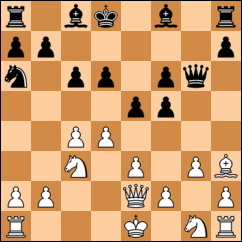
12...Bh6
Will is setting up to push his f-pawn. An interesting alternative is to play 12...exd4!? first, trading pawns, then play ...Bh6.
13.Nf3 f4
This alarming-looking move is actually not bad for Steve at all, because his misplaced kingside bishop gets to go out in a blaze of glory, taking out its counterpart on c8. Does Will have an alternative? Well, there's 13...exd4 14.Nxd4 (14.exd4?? is terrible because of 14...Re8) 14...f4 15.Bxc8 Kxc8 16.gxf4 (again, not 16.exf4? because of 16...Re8 17.Ne6 Nc5) 16...Bxf4 17.0-0-0 (17.exf4 is not as good because of -- you guessed it! -- 17...Re8).
14.Bxc8 Rxc8
Surprisingly, 14...Kxc8 really is better. Will can't castle anymore anyway, and 14...Kxc8 pulls his king just a little farther out of harm's way.
15.0-0
What? This is mystifying. Why put the king on the g-file when Will's queen is staring straight down it? In this case, castling does not provide king safety. Why not play 15.gxf4, threatening dxe5, 0-0-0 (with potential check) and Rhg1, instead?
15...fxe3 16.fxe3 Re8
It's as if both players are trying their darnedest not to allow any path to open up through the center, even if they can do it in an advantageous way.
17.d5
Finally some movement in the center. Steve is looking good. Will, perhaps feeling the pressure, makes a couple of eyebrow-raising moves in reply.
17...Nb4?
There's a pin combo in 17...Qg4 and 18...e4. Perhaps the point of Will's 17th move is to prepare 18...Qd3 or 18...Qc2, but both are easily thwarted by Steve's playing 18.e4.
18.Nh4 Qg5?
The welcome mat is out, but Will doesn't accept the invitation. Now the door slams.
19.Nf5 Kc7 20.Rad1
The e4-square is huge huge huge, yet neither Steve nor Will has moved to occupy it since move 15. Why the blind spot? 20.Ne4! Qg6 21.Nexd6 Bf8 22.Nxc8 Kxc8 is devastating for Steve.
20...Rcd8?
Why? Why? 20...e4. Come on, please?
21.a3 Na6 22.Ne4
Finally!
22...Qg6 23.dxc6 bxc6 24.Nexd6 Re6
Steve is only a pawn up in material, but positionally, he's dominating the board. Now he has an incredible (but complicated) tactical opportunity: 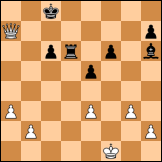 25.c5!! dares Will to take the pawn, and Will cannot but accept the dare with 25...Nxc5, whereupon 26.Qc4 forks rook and knight. The line proceeds 26...Rdxd6 27.Qxc5 Qxf5 28.Qxa7+ Kc8 29.Rxd6 Qxf1+ (29...Rxd6?? 30.Rxf5) 30.Kxf1 Rxd6, and Steve finishes with a queen and a pawn against a rook and a bishop (diagram).
25.c5!! dares Will to take the pawn, and Will cannot but accept the dare with 25...Nxc5, whereupon 26.Qc4 forks rook and knight. The line proceeds 26...Rdxd6 27.Qxc5 Qxf5 28.Qxa7+ Kc8 29.Rxd6 Qxf1+ (29...Rxd6?? 30.Rxf5) 30.Kxf1 Rxd6, and Steve finishes with a queen and a pawn against a rook and a bishop (diagram).
 25.c5!! dares Will to take the pawn, and Will cannot but accept the dare with 25...Nxc5, whereupon 26.Qc4 forks rook and knight. The line proceeds 26...Rdxd6 27.Qxc5 Qxf5 28.Qxa7+ Kc8 29.Rxd6 Qxf1+ (29...Rxd6?? 30.Rxf5) 30.Kxf1 Rxd6, and Steve finishes with a queen and a pawn against a rook and a bishop (diagram).
25.c5!! dares Will to take the pawn, and Will cannot but accept the dare with 25...Nxc5, whereupon 26.Qc4 forks rook and knight. The line proceeds 26...Rdxd6 27.Qxc5 Qxf5 28.Qxa7+ Kc8 29.Rxd6 Qxf1+ (29...Rxd6?? 30.Rxf5) 30.Kxf1 Rxd6, and Steve finishes with a queen and a pawn against a rook and a bishop (diagram).In reality, it doesn't happen quite that way.
25.Nxh6 Rexd6 26.Rxd6 Rxd6 27.Nf5 Rd8
The position is still significantly better for Steve -- in particular, Will's knight is awfully placed -- but the path to victory is murky.
28.e4 Qg5 29.Ne3
Oh, no. Steve's knight is spooked off a secure outpost square, and the pressure begins to bleed off. Compare this submissive move with the iron-fisted 29.Rd1 Nc5 30.Rxd8 Kxd8 31.Qd1+ Nd7. The pawns can take it from there.
29...Rd4 30.Rf5 Qh6 31.Rh5
Not bad per se . . . but if I had a rook, I don't think that's the part of the board I'd want it on.
31...Qg6 32.Nf5
Back where it belongs.
32...Rxe4 33.Qxe4 Qh5
Steve's pawn advantage is gone now. Positionally, the main thing he has going for him is Will's passively placed knight.
34.b4
This second-best move is the crack that Will needs to claw his way back into the game.
34...Qd1+
34.Qd3 would have suppressed this move. Now, suddenly, Steve is on the defensive.
35.Kg2 Qb3 36.b5
Only 36.Qe3 Qxe3 37.Nxe3 maintains a meaningful advantage.
36...cxb5 37.Qd5??
What will it profit him to save a pawn and forfeit a knight? By taking protection off c2, Steve permits the king-knight fork 37...Qc2+.
37...Qxc4
This is nearly as bad, since Will has now gone from being one pawn down to two pawns up.
38.Qd6+ Kb7 39.Qd7+ Kb6
40.Qd6+??
40.Qd8+ Nc7 41.Qxf6+ Qe6 42.Qf8 might hold on for a while. As it is, it's going to go downhill rapidly from here.
40...Qc6+ 41.Qxc6+ Kxc6+ 42.Kf3 b4 43.axb4 Nxb4 44.Ke4 Kc5 45.h4 a5 46.Ne3 a4 47.Nd1 Nd5 48.Kd3
48...e4+! 49.Kxe4 a3 0-1

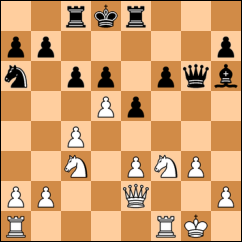
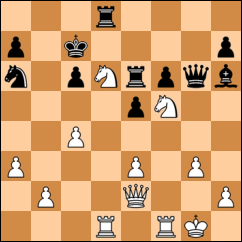
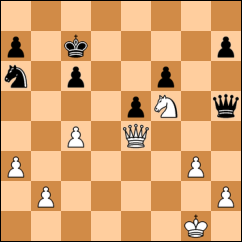
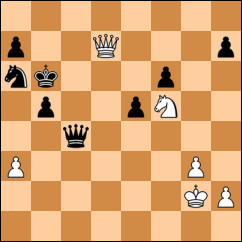
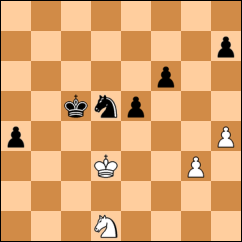



1 comments:
after 19...Kc7, White should be able to win the exchange with 20 a3 Na6 21. dxc6 bxc6 22. Ne4 Qg6 23. Nexd6 forking the Rooks
Post a Comment